A Report on Dreamworld Disaster: Legal and Risk Management Strategies
VerifiedAdded on 2023/01/03
|8
|1846
|21
Report
AI Summary
This report provides a comprehensive analysis of the Dreamworld theme park disaster, focusing on the legal obligations of the company and the strategies for managing various risks. The report examines the legal implications of ride accidents, including compliance with safety procedures, statutory defenses, prior acceptance of risk, and maintaining standards of care. It also addresses risk management against theft, outlining strategies such as prior responsibility, security provisions, and technological aspects. Furthermore, the report explores the impact of COVID-19 on the park's operations and recommends integrating statutory protocols, modifying operations, and implementing daily health checks. The report concludes with recommendations for consistent policy implementation and technological upgrades to minimize legal risks and ensure visitor safety. The report covers the accident on the Thunder River Rapid ride, the legal charges, and obligations under contract law and the law of negligence. The report also discusses the effects of exclusion clauses and the importance of work and safety practices. Finally, the report provides recommendations based on the legal risks identified and the obligations of Dreamworld regarding the law and its compliance.
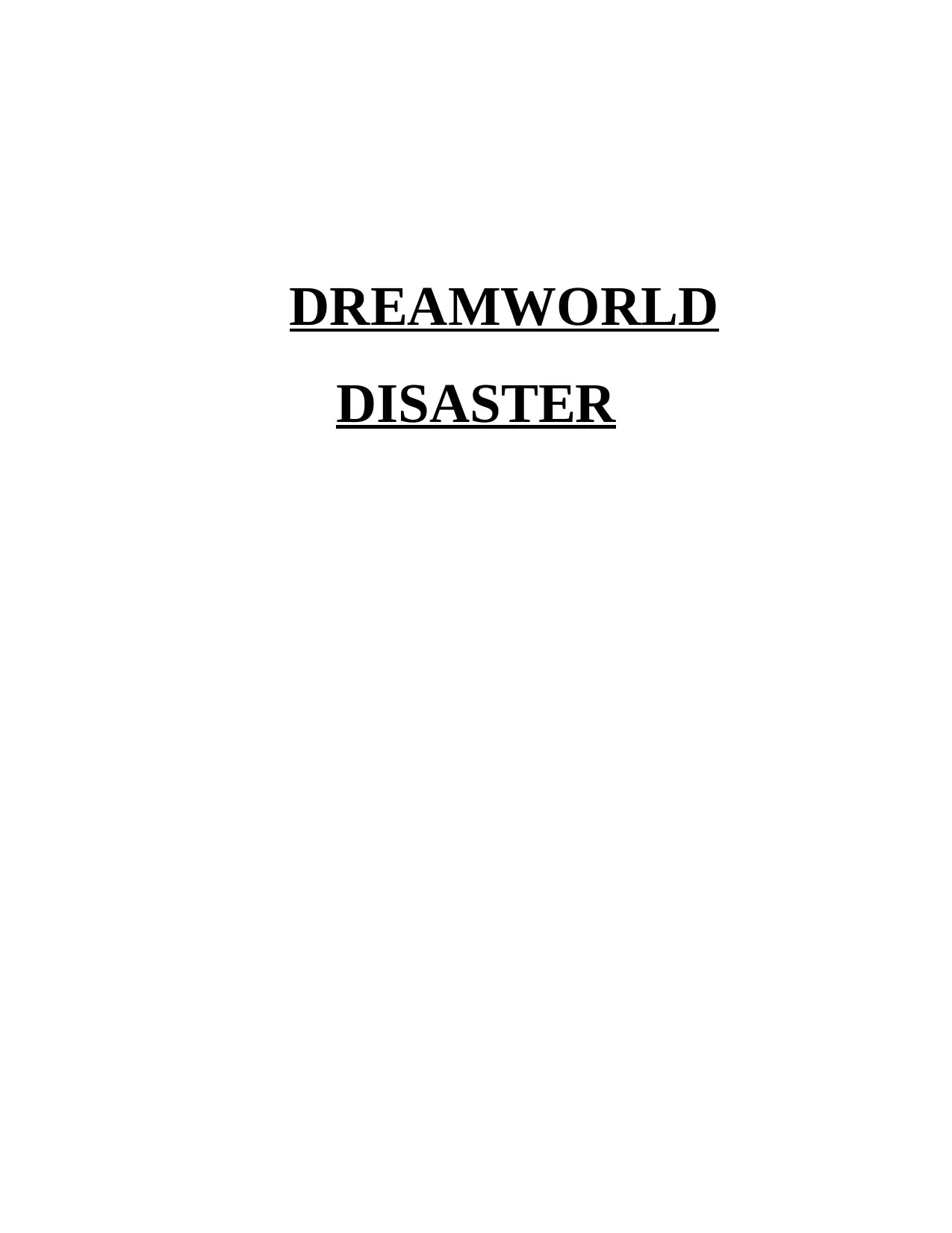
DREAMWORLD
DISASTER
DISASTER
Paraphrase This Document
Need a fresh take? Get an instant paraphrase of this document with our AI Paraphraser
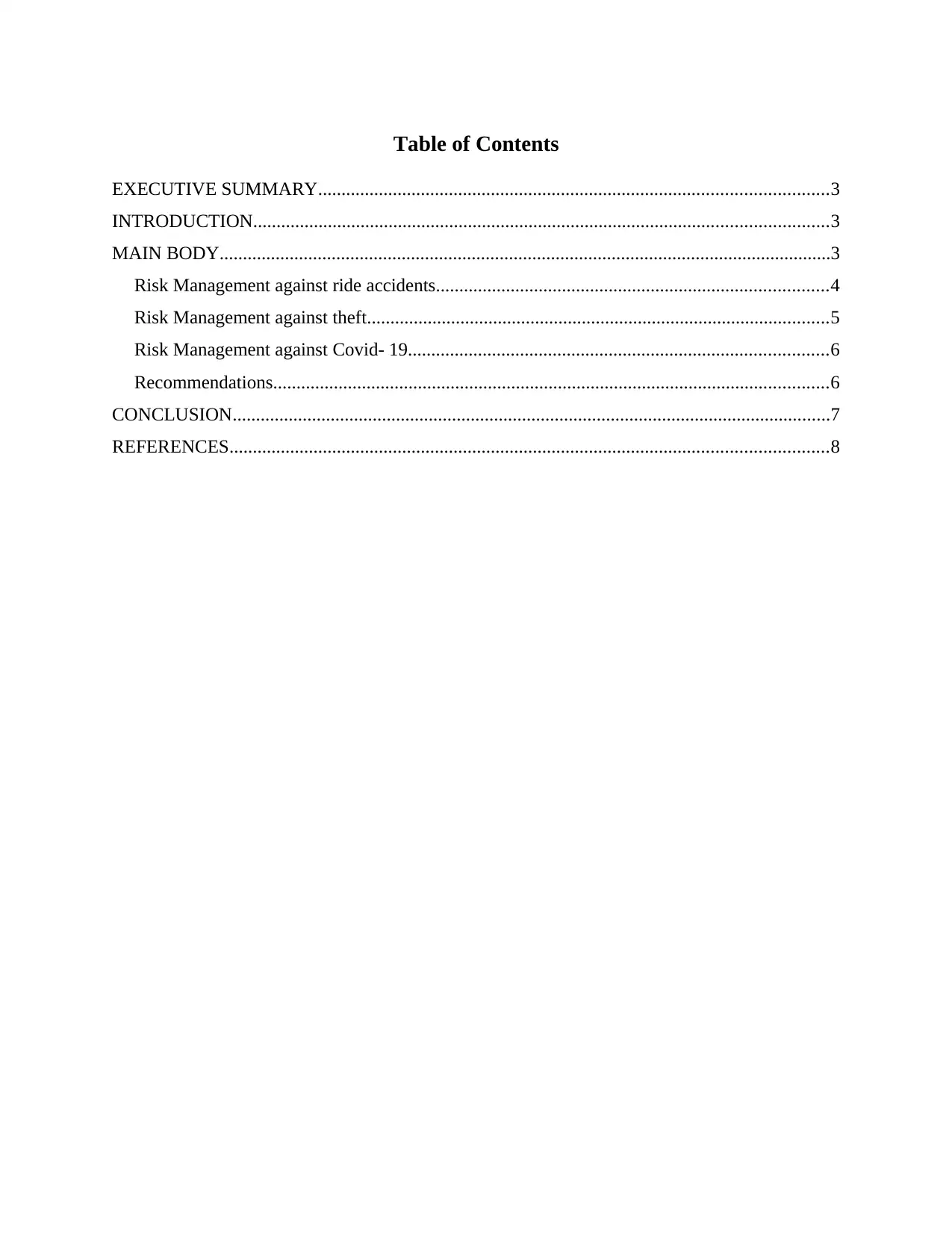
Table of Contents
EXECUTIVE SUMMARY.............................................................................................................3
INTRODUCTION...........................................................................................................................3
MAIN BODY...................................................................................................................................3
Risk Management against ride accidents....................................................................................4
Risk Management against theft...................................................................................................5
Risk Management against Covid- 19..........................................................................................6
Recommendations.......................................................................................................................6
CONCLUSION................................................................................................................................7
REFERENCES................................................................................................................................8
EXECUTIVE SUMMARY.............................................................................................................3
INTRODUCTION...........................................................................................................................3
MAIN BODY...................................................................................................................................3
Risk Management against ride accidents....................................................................................4
Risk Management against theft...................................................................................................5
Risk Management against Covid- 19..........................................................................................6
Recommendations.......................................................................................................................6
CONCLUSION................................................................................................................................7
REFERENCES................................................................................................................................8
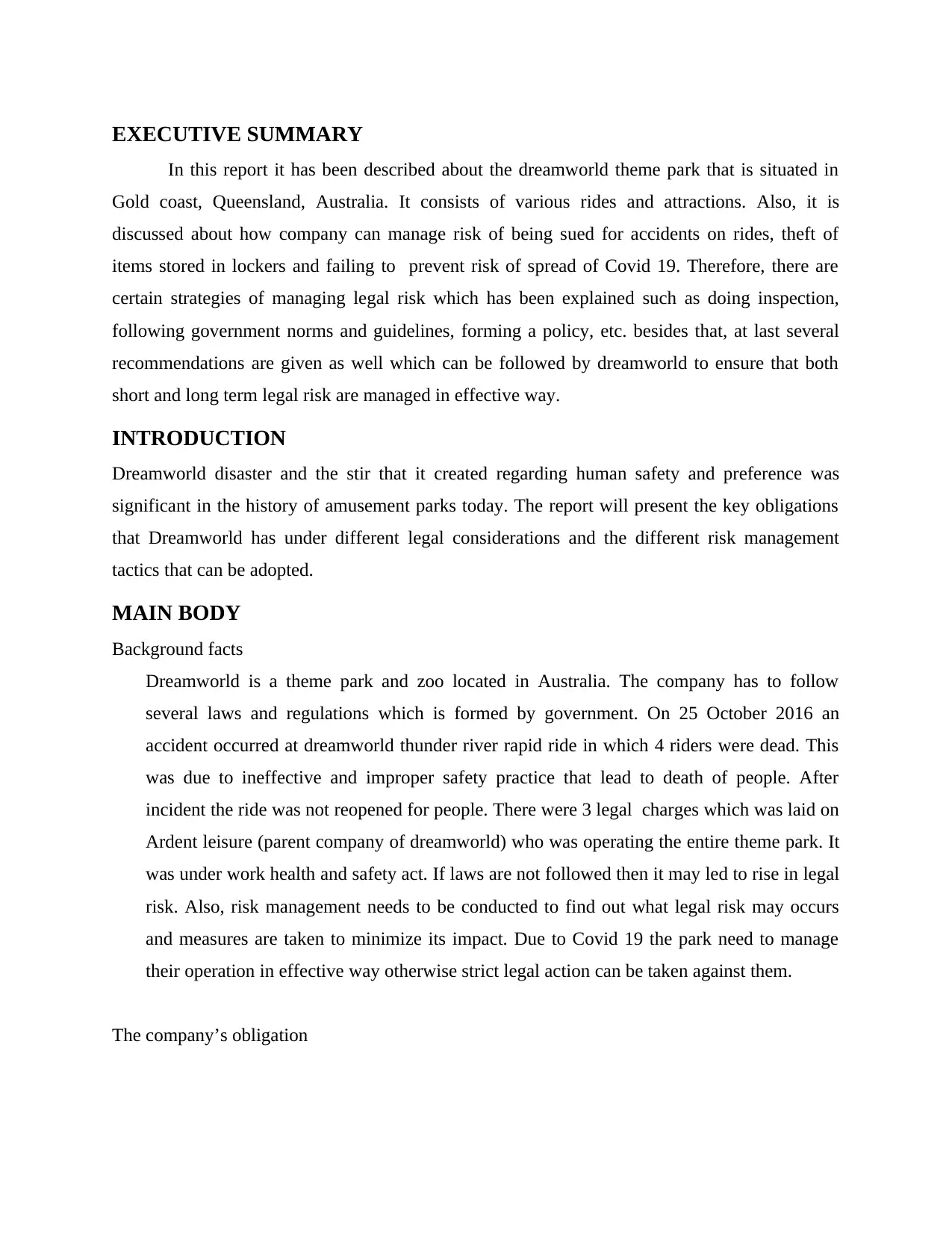
EXECUTIVE SUMMARY
In this report it has been described about the dreamworld theme park that is situated in
Gold coast, Queensland, Australia. It consists of various rides and attractions. Also, it is
discussed about how company can manage risk of being sued for accidents on rides, theft of
items stored in lockers and failing to prevent risk of spread of Covid 19. Therefore, there are
certain strategies of managing legal risk which has been explained such as doing inspection,
following government norms and guidelines, forming a policy, etc. besides that, at last several
recommendations are given as well which can be followed by dreamworld to ensure that both
short and long term legal risk are managed in effective way.
INTRODUCTION
Dreamworld disaster and the stir that it created regarding human safety and preference was
significant in the history of amusement parks today. The report will present the key obligations
that Dreamworld has under different legal considerations and the different risk management
tactics that can be adopted.
MAIN BODY
Background facts
Dreamworld is a theme park and zoo located in Australia. The company has to follow
several laws and regulations which is formed by government. On 25 October 2016 an
accident occurred at dreamworld thunder river rapid ride in which 4 riders were dead. This
was due to ineffective and improper safety practice that lead to death of people. After
incident the ride was not reopened for people. There were 3 legal charges which was laid on
Ardent leisure (parent company of dreamworld) who was operating the entire theme park. It
was under work health and safety act. If laws are not followed then it may led to rise in legal
risk. Also, risk management needs to be conducted to find out what legal risk may occurs
and measures are taken to minimize its impact. Due to Covid 19 the park need to manage
their operation in effective way otherwise strict legal action can be taken against them.
The company’s obligation
In this report it has been described about the dreamworld theme park that is situated in
Gold coast, Queensland, Australia. It consists of various rides and attractions. Also, it is
discussed about how company can manage risk of being sued for accidents on rides, theft of
items stored in lockers and failing to prevent risk of spread of Covid 19. Therefore, there are
certain strategies of managing legal risk which has been explained such as doing inspection,
following government norms and guidelines, forming a policy, etc. besides that, at last several
recommendations are given as well which can be followed by dreamworld to ensure that both
short and long term legal risk are managed in effective way.
INTRODUCTION
Dreamworld disaster and the stir that it created regarding human safety and preference was
significant in the history of amusement parks today. The report will present the key obligations
that Dreamworld has under different legal considerations and the different risk management
tactics that can be adopted.
MAIN BODY
Background facts
Dreamworld is a theme park and zoo located in Australia. The company has to follow
several laws and regulations which is formed by government. On 25 October 2016 an
accident occurred at dreamworld thunder river rapid ride in which 4 riders were dead. This
was due to ineffective and improper safety practice that lead to death of people. After
incident the ride was not reopened for people. There were 3 legal charges which was laid on
Ardent leisure (parent company of dreamworld) who was operating the entire theme park. It
was under work health and safety act. If laws are not followed then it may led to rise in legal
risk. Also, risk management needs to be conducted to find out what legal risk may occurs
and measures are taken to minimize its impact. Due to Covid 19 the park need to manage
their operation in effective way otherwise strict legal action can be taken against them.
The company’s obligation
⊘ This is a preview!⊘
Do you want full access?
Subscribe today to unlock all pages.

Trusted by 1+ million students worldwide
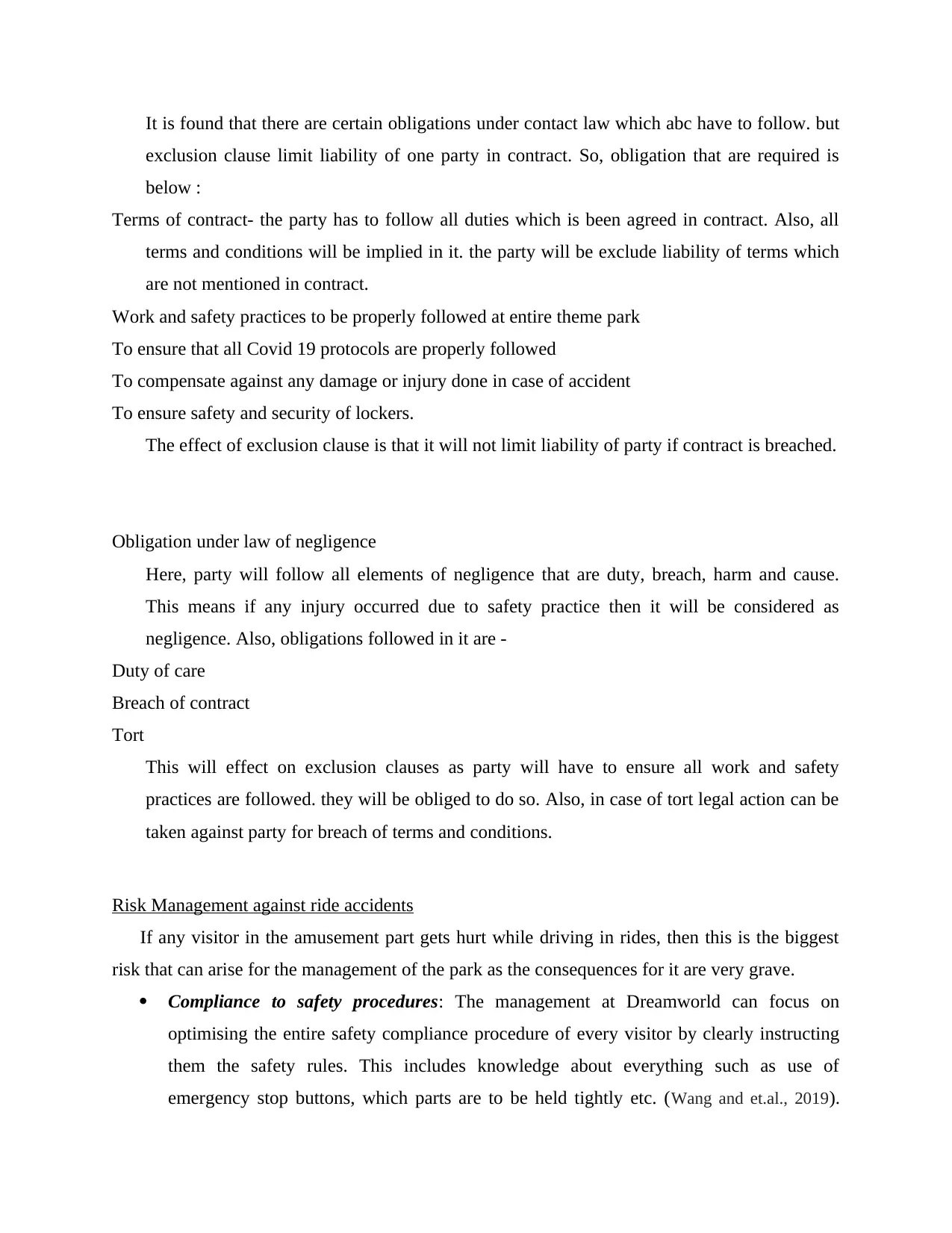
It is found that there are certain obligations under contact law which abc have to follow. but
exclusion clause limit liability of one party in contract. So, obligation that are required is
below :
Terms of contract- the party has to follow all duties which is been agreed in contract. Also, all
terms and conditions will be implied in it. the party will be exclude liability of terms which
are not mentioned in contract.
Work and safety practices to be properly followed at entire theme park
To ensure that all Covid 19 protocols are properly followed
To compensate against any damage or injury done in case of accident
To ensure safety and security of lockers.
The effect of exclusion clause is that it will not limit liability of party if contract is breached.
Obligation under law of negligence
Here, party will follow all elements of negligence that are duty, breach, harm and cause.
This means if any injury occurred due to safety practice then it will be considered as
negligence. Also, obligations followed in it are -
Duty of care
Breach of contract
Tort
This will effect on exclusion clauses as party will have to ensure all work and safety
practices are followed. they will be obliged to do so. Also, in case of tort legal action can be
taken against party for breach of terms and conditions.
Risk Management against ride accidents
If any visitor in the amusement part gets hurt while driving in rides, then this is the biggest
risk that can arise for the management of the park as the consequences for it are very grave.
Compliance to safety procedures: The management at Dreamworld can focus on
optimising the entire safety compliance procedure of every visitor by clearly instructing
them the safety rules. This includes knowledge about everything such as use of
emergency stop buttons, which parts are to be held tightly etc. (Wang and et.al., 2019).
exclusion clause limit liability of one party in contract. So, obligation that are required is
below :
Terms of contract- the party has to follow all duties which is been agreed in contract. Also, all
terms and conditions will be implied in it. the party will be exclude liability of terms which
are not mentioned in contract.
Work and safety practices to be properly followed at entire theme park
To ensure that all Covid 19 protocols are properly followed
To compensate against any damage or injury done in case of accident
To ensure safety and security of lockers.
The effect of exclusion clause is that it will not limit liability of party if contract is breached.
Obligation under law of negligence
Here, party will follow all elements of negligence that are duty, breach, harm and cause.
This means if any injury occurred due to safety practice then it will be considered as
negligence. Also, obligations followed in it are -
Duty of care
Breach of contract
Tort
This will effect on exclusion clauses as party will have to ensure all work and safety
practices are followed. they will be obliged to do so. Also, in case of tort legal action can be
taken against party for breach of terms and conditions.
Risk Management against ride accidents
If any visitor in the amusement part gets hurt while driving in rides, then this is the biggest
risk that can arise for the management of the park as the consequences for it are very grave.
Compliance to safety procedures: The management at Dreamworld can focus on
optimising the entire safety compliance procedure of every visitor by clearly instructing
them the safety rules. This includes knowledge about everything such as use of
emergency stop buttons, which parts are to be held tightly etc. (Wang and et.al., 2019).
Paraphrase This Document
Need a fresh take? Get an instant paraphrase of this document with our AI Paraphraser
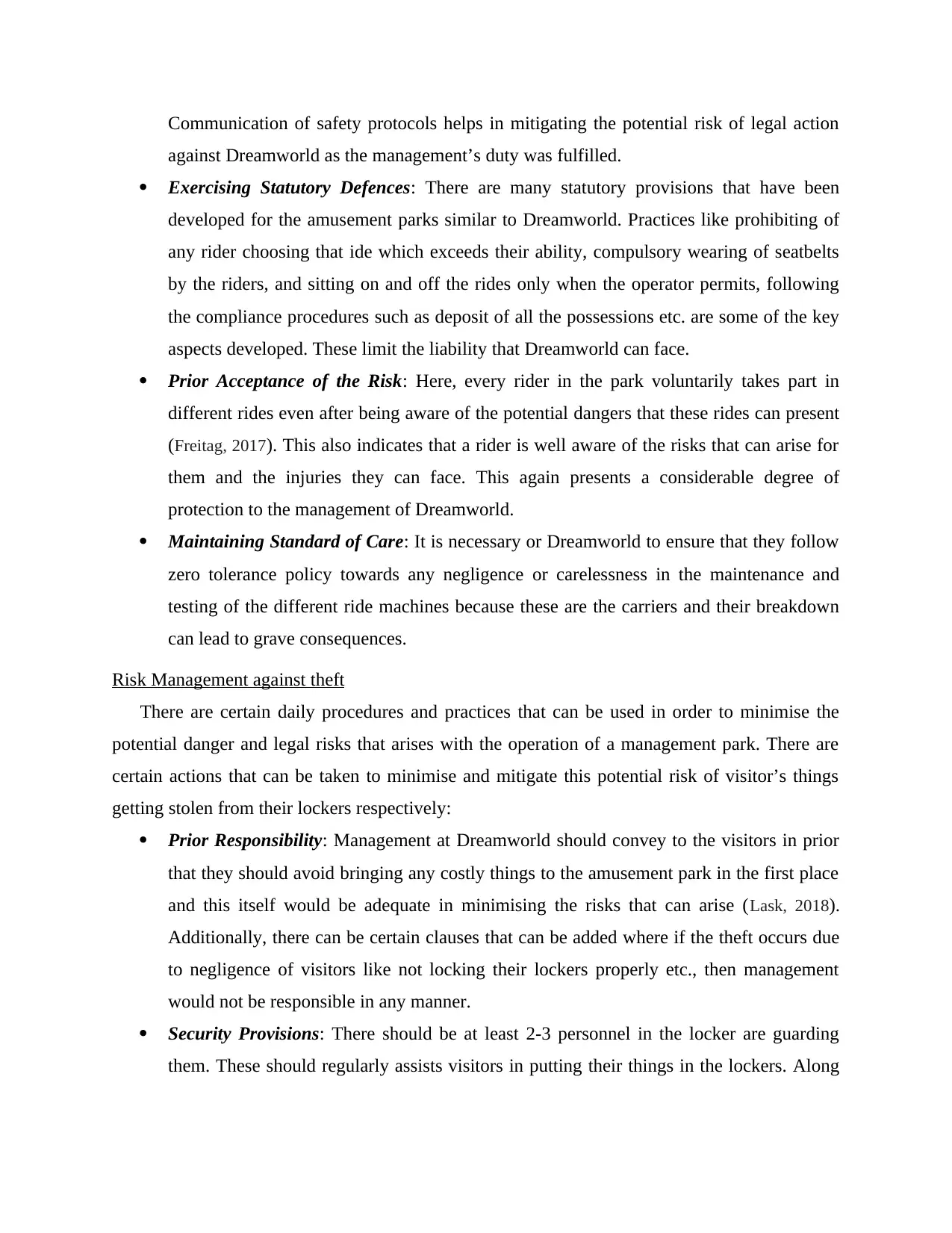
Communication of safety protocols helps in mitigating the potential risk of legal action
against Dreamworld as the management’s duty was fulfilled.
Exercising Statutory Defences: There are many statutory provisions that have been
developed for the amusement parks similar to Dreamworld. Practices like prohibiting of
any rider choosing that ide which exceeds their ability, compulsory wearing of seatbelts
by the riders, and sitting on and off the rides only when the operator permits, following
the compliance procedures such as deposit of all the possessions etc. are some of the key
aspects developed. These limit the liability that Dreamworld can face.
Prior Acceptance of the Risk: Here, every rider in the park voluntarily takes part in
different rides even after being aware of the potential dangers that these rides can present
(Freitag, 2017). This also indicates that a rider is well aware of the risks that can arise for
them and the injuries they can face. This again presents a considerable degree of
protection to the management of Dreamworld.
Maintaining Standard of Care: It is necessary or Dreamworld to ensure that they follow
zero tolerance policy towards any negligence or carelessness in the maintenance and
testing of the different ride machines because these are the carriers and their breakdown
can lead to grave consequences.
Risk Management against theft
There are certain daily procedures and practices that can be used in order to minimise the
potential danger and legal risks that arises with the operation of a management park. There are
certain actions that can be taken to minimise and mitigate this potential risk of visitor’s things
getting stolen from their lockers respectively:
Prior Responsibility: Management at Dreamworld should convey to the visitors in prior
that they should avoid bringing any costly things to the amusement park in the first place
and this itself would be adequate in minimising the risks that can arise (Lask, 2018).
Additionally, there can be certain clauses that can be added where if the theft occurs due
to negligence of visitors like not locking their lockers properly etc., then management
would not be responsible in any manner.
Security Provisions: There should be at least 2-3 personnel in the locker are guarding
them. These should regularly assists visitors in putting their things in the lockers. Along
against Dreamworld as the management’s duty was fulfilled.
Exercising Statutory Defences: There are many statutory provisions that have been
developed for the amusement parks similar to Dreamworld. Practices like prohibiting of
any rider choosing that ide which exceeds their ability, compulsory wearing of seatbelts
by the riders, and sitting on and off the rides only when the operator permits, following
the compliance procedures such as deposit of all the possessions etc. are some of the key
aspects developed. These limit the liability that Dreamworld can face.
Prior Acceptance of the Risk: Here, every rider in the park voluntarily takes part in
different rides even after being aware of the potential dangers that these rides can present
(Freitag, 2017). This also indicates that a rider is well aware of the risks that can arise for
them and the injuries they can face. This again presents a considerable degree of
protection to the management of Dreamworld.
Maintaining Standard of Care: It is necessary or Dreamworld to ensure that they follow
zero tolerance policy towards any negligence or carelessness in the maintenance and
testing of the different ride machines because these are the carriers and their breakdown
can lead to grave consequences.
Risk Management against theft
There are certain daily procedures and practices that can be used in order to minimise the
potential danger and legal risks that arises with the operation of a management park. There are
certain actions that can be taken to minimise and mitigate this potential risk of visitor’s things
getting stolen from their lockers respectively:
Prior Responsibility: Management at Dreamworld should convey to the visitors in prior
that they should avoid bringing any costly things to the amusement park in the first place
and this itself would be adequate in minimising the risks that can arise (Lask, 2018).
Additionally, there can be certain clauses that can be added where if the theft occurs due
to negligence of visitors like not locking their lockers properly etc., then management
would not be responsible in any manner.
Security Provisions: There should be at least 2-3 personnel in the locker are guarding
them. These should regularly assists visitors in putting their things in the lockers. Along
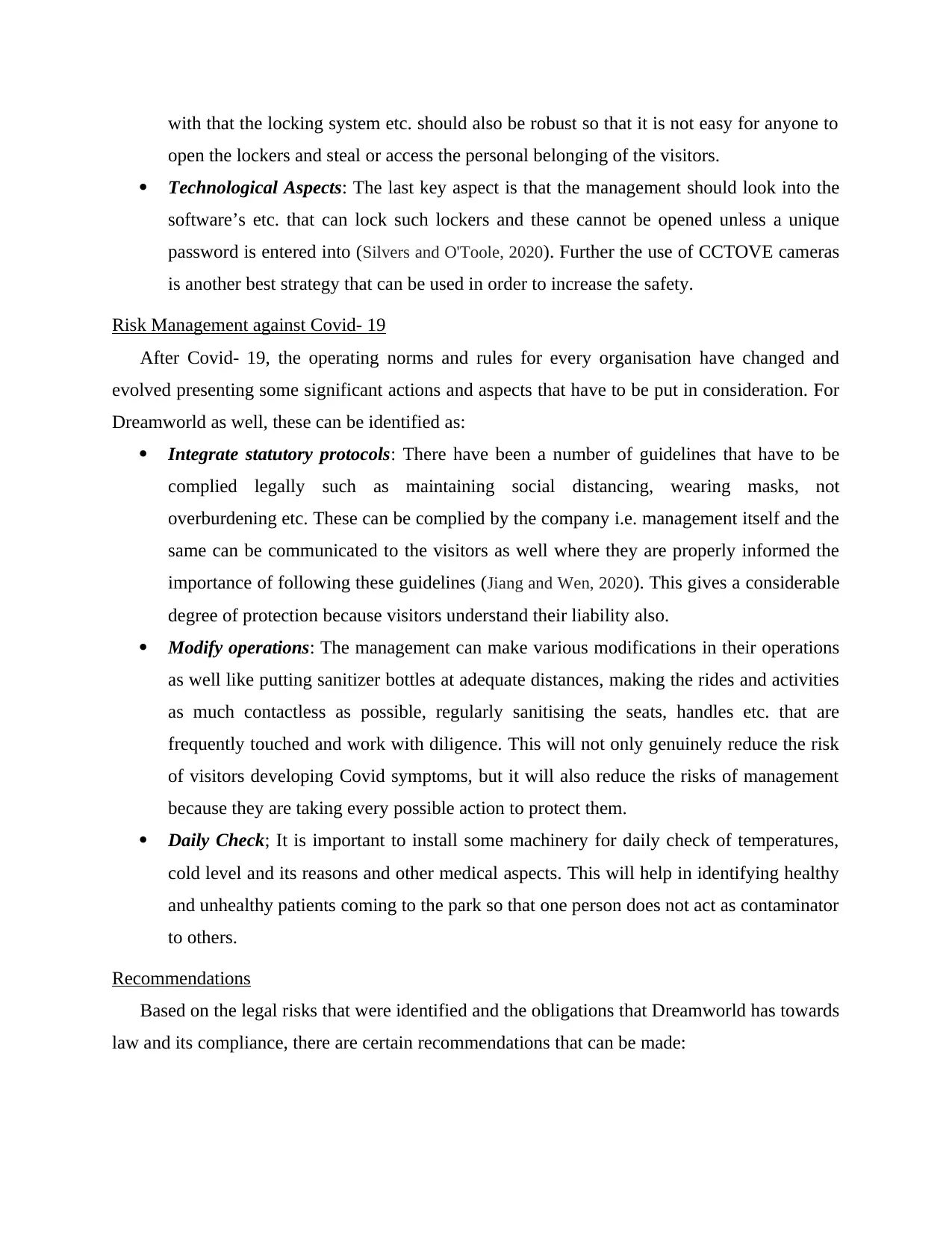
with that the locking system etc. should also be robust so that it is not easy for anyone to
open the lockers and steal or access the personal belonging of the visitors.
Technological Aspects: The last key aspect is that the management should look into the
software’s etc. that can lock such lockers and these cannot be opened unless a unique
password is entered into (Silvers and O'Toole, 2020). Further the use of CCTOVE cameras
is another best strategy that can be used in order to increase the safety.
Risk Management against Covid- 19
After Covid- 19, the operating norms and rules for every organisation have changed and
evolved presenting some significant actions and aspects that have to be put in consideration. For
Dreamworld as well, these can be identified as:
Integrate statutory protocols: There have been a number of guidelines that have to be
complied legally such as maintaining social distancing, wearing masks, not
overburdening etc. These can be complied by the company i.e. management itself and the
same can be communicated to the visitors as well where they are properly informed the
importance of following these guidelines (Jiang and Wen, 2020). This gives a considerable
degree of protection because visitors understand their liability also.
Modify operations: The management can make various modifications in their operations
as well like putting sanitizer bottles at adequate distances, making the rides and activities
as much contactless as possible, regularly sanitising the seats, handles etc. that are
frequently touched and work with diligence. This will not only genuinely reduce the risk
of visitors developing Covid symptoms, but it will also reduce the risks of management
because they are taking every possible action to protect them.
Daily Check; It is important to install some machinery for daily check of temperatures,
cold level and its reasons and other medical aspects. This will help in identifying healthy
and unhealthy patients coming to the park so that one person does not act as contaminator
to others.
Recommendations
Based on the legal risks that were identified and the obligations that Dreamworld has towards
law and its compliance, there are certain recommendations that can be made:
open the lockers and steal or access the personal belonging of the visitors.
Technological Aspects: The last key aspect is that the management should look into the
software’s etc. that can lock such lockers and these cannot be opened unless a unique
password is entered into (Silvers and O'Toole, 2020). Further the use of CCTOVE cameras
is another best strategy that can be used in order to increase the safety.
Risk Management against Covid- 19
After Covid- 19, the operating norms and rules for every organisation have changed and
evolved presenting some significant actions and aspects that have to be put in consideration. For
Dreamworld as well, these can be identified as:
Integrate statutory protocols: There have been a number of guidelines that have to be
complied legally such as maintaining social distancing, wearing masks, not
overburdening etc. These can be complied by the company i.e. management itself and the
same can be communicated to the visitors as well where they are properly informed the
importance of following these guidelines (Jiang and Wen, 2020). This gives a considerable
degree of protection because visitors understand their liability also.
Modify operations: The management can make various modifications in their operations
as well like putting sanitizer bottles at adequate distances, making the rides and activities
as much contactless as possible, regularly sanitising the seats, handles etc. that are
frequently touched and work with diligence. This will not only genuinely reduce the risk
of visitors developing Covid symptoms, but it will also reduce the risks of management
because they are taking every possible action to protect them.
Daily Check; It is important to install some machinery for daily check of temperatures,
cold level and its reasons and other medical aspects. This will help in identifying healthy
and unhealthy patients coming to the park so that one person does not act as contaminator
to others.
Recommendations
Based on the legal risks that were identified and the obligations that Dreamworld has towards
law and its compliance, there are certain recommendations that can be made:
⊘ This is a preview!⊘
Do you want full access?
Subscribe today to unlock all pages.

Trusted by 1+ million students worldwide
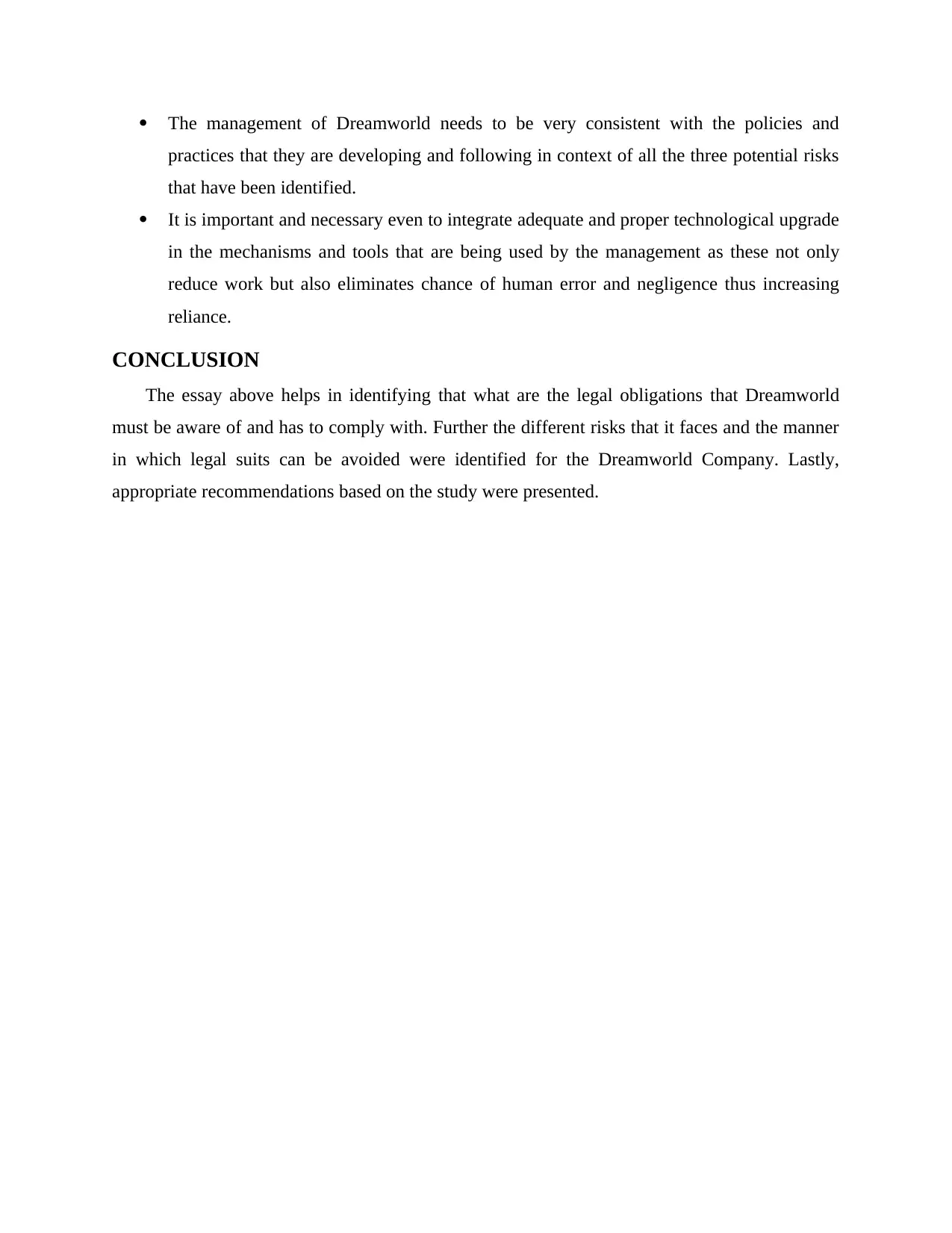
The management of Dreamworld needs to be very consistent with the policies and
practices that they are developing and following in context of all the three potential risks
that have been identified.
It is important and necessary even to integrate adequate and proper technological upgrade
in the mechanisms and tools that are being used by the management as these not only
reduce work but also eliminates chance of human error and negligence thus increasing
reliance.
CONCLUSION
The essay above helps in identifying that what are the legal obligations that Dreamworld
must be aware of and has to comply with. Further the different risks that it faces and the manner
in which legal suits can be avoided were identified for the Dreamworld Company. Lastly,
appropriate recommendations based on the study were presented.
practices that they are developing and following in context of all the three potential risks
that have been identified.
It is important and necessary even to integrate adequate and proper technological upgrade
in the mechanisms and tools that are being used by the management as these not only
reduce work but also eliminates chance of human error and negligence thus increasing
reliance.
CONCLUSION
The essay above helps in identifying that what are the legal obligations that Dreamworld
must be aware of and has to comply with. Further the different risks that it faces and the manner
in which legal suits can be avoided were identified for the Dreamworld Company. Lastly,
appropriate recommendations based on the study were presented.
Paraphrase This Document
Need a fresh take? Get an instant paraphrase of this document with our AI Paraphraser
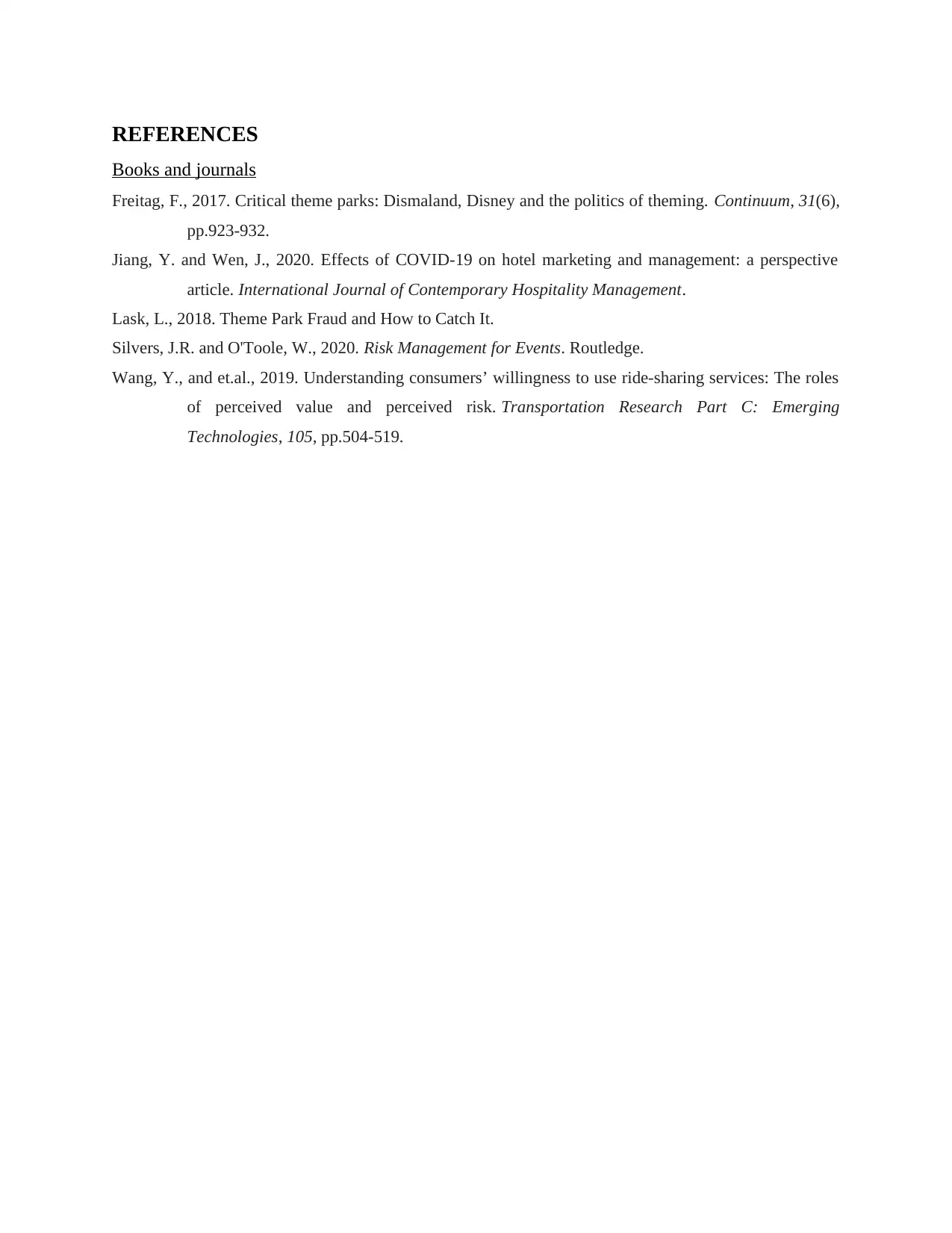
REFERENCES
Books and journals
Freitag, F., 2017. Critical theme parks: Dismaland, Disney and the politics of theming. Continuum, 31(6),
pp.923-932.
Jiang, Y. and Wen, J., 2020. Effects of COVID-19 on hotel marketing and management: a perspective
article. International Journal of Contemporary Hospitality Management.
Lask, L., 2018. Theme Park Fraud and How to Catch It.
Silvers, J.R. and O'Toole, W., 2020. Risk Management for Events. Routledge.
Wang, Y., and et.al., 2019. Understanding consumers’ willingness to use ride-sharing services: The roles
of perceived value and perceived risk. Transportation Research Part C: Emerging
Technologies, 105, pp.504-519.
Books and journals
Freitag, F., 2017. Critical theme parks: Dismaland, Disney and the politics of theming. Continuum, 31(6),
pp.923-932.
Jiang, Y. and Wen, J., 2020. Effects of COVID-19 on hotel marketing and management: a perspective
article. International Journal of Contemporary Hospitality Management.
Lask, L., 2018. Theme Park Fraud and How to Catch It.
Silvers, J.R. and O'Toole, W., 2020. Risk Management for Events. Routledge.
Wang, Y., and et.al., 2019. Understanding consumers’ willingness to use ride-sharing services: The roles
of perceived value and perceived risk. Transportation Research Part C: Emerging
Technologies, 105, pp.504-519.
1 out of 8
Related Documents
Your All-in-One AI-Powered Toolkit for Academic Success.
+13062052269
info@desklib.com
Available 24*7 on WhatsApp / Email
![[object Object]](/_next/static/media/star-bottom.7253800d.svg)
Unlock your academic potential
Copyright © 2020–2025 A2Z Services. All Rights Reserved. Developed and managed by ZUCOL.




